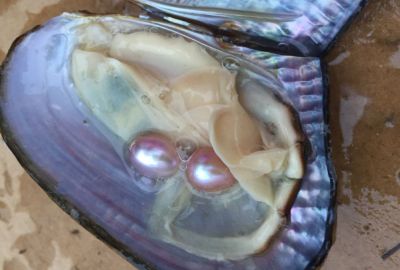Pearl

The pearl is a defense response of a shellfish when a foreign body enters the shell. The epithelial cells of the mantle cover the foreign body with many layers of calcium carbonate in microcrystalline form. The process of human implantation of a foreign body in the shell, and the cultivation of pearl shells in the open sea, was by the British biologist William Saville-Kent. Transported to Japan by Tokichi Nishikawa and Tatsuhei Mise.
Mikimoto Kokichi, gave its name to one of the most famous varieties of high quality pearls, the famous Mikimoto Akoya pearls. In 1917, Mitsubishi Baron Iwasaki, systematized the mass cultivation of pearls in the Philippines (South sea pearls). In 1914, the first freshwater pearl cultivation began on Lake Biwa, a few miles outside the city of Kyoto in Japan. Hence the international name Biwa freshwater pearls, which for many years prevailed as a trademark of cultured pearls
Intensive breeding of millions of shellfish, rising industrial production and pesticide use in the riparian zone, polluted the waters of Japan's largest and oldest lake Biwa, so pearl farming was transferred in 1971 to Lake Kasumigaura.
In 1975 pearl cultivation was transferred to China, in Shanghai, that became the world center of freshwater pearls production.
We also have pearl cultivation in Tahiti, including the famousTahitian black pearls. In Australia, we can find the rare and very expensive blue pearl, in Myanmar (Burma) and Indian Ocean pearl farms production early 90s. In 2013, 43% of South Sea pearls production came from Indonesia. The time to create a pearl varies from 1-2 years for saltwater pearls (Akoya pearls) or 2-7 years for fresh water pearls. Today, 99% of the global pearl market comes from pearl shell farms, either saltwater (Akoya) or freshwater pearls. The value of a pearl is determined by its luster, iridescence, size, shape, symmetry, surface imperfections.
The largest known pearl was found in 1934 on the island of Palawan in the Philippines. It is a huge natural pearl, 24 cm in diameter and weighing 6.4 kg, from the Tridacna Gigas species. The pearl is known as the "Pearl of Lao Tzu".
In ancient mythology, pearls are the expression of Passion, Beauty and Purity.
The tears of Isis in Egyptian mythology, the tears of Eve and Adam after Abel's death, the tears of joy of Aphrodite, when she first saw the daylight, the tears of the angels in the Middle Ages,express the love for this miracle of Nature. The magnificent and world famous painting by Sandro Botticelli (the Birth of Aphrodite), is the influence of pearls on human Art and civilization.
Cleopatra dissolved a very expensive pearl in vinegar and drank it in front of Marco Antonio, telling him that nothing in the world, no matter how expensive it is, has the value of Cleopatra 's desire.
Elizabeth I of England, the Virgin Queen was a lover of pearls, as a symbol of virginity and purity. The fourteen-year-old Catherine of Medici first appeared to her future husband Henry II, wearing six rows of the largest and most valuable pearls.
But no pearl is as valuable as the legendary "La Pellegrina", the wandering pilgrim. From the waters of Panama or Venezuela, and the hands of a slave, the pearl went through wars and unsolved murders in the hands of Philip II of Spain. It was the only jewel that Mary Tudor wore as a bride at her wedding to Philip. Louis-Napoleon bought the pearl from Philip IV, but sold it to the Marquis of Abercorn.
Years later, Richard Burton bought it at Sotheby's auction for $ 370,000 as a gift to Elisabeth Taylor. Today we assume that "Pellegrina" belongs to a private collection.
In 1972, Burton bought a 1554 portrait of Mary Tudor with the legendary pearl for $ 270,000, which he donated to the National Gallery in London a few years later.
The pearl, directly connected with the Lotus, belongs to the second Chakra, Swadisthana, the chakra of purity, of our female entity, of Love and fertility. It symbolizes the energy of the Moon, calms the troubled soul and impels sexuality.
Indians and Chinese drink strong alcohol with rubbed pearls to cure sexuality.
It is a powerful symbol of the Moon, it symbolizes wisdom, peace and pure love.
Chlorine, salt, many chemicals and alcohol tarnish the pearl, so we recommend that you carefully wear this delicate organic masterpiece of Nature.

 Ελληνικά
Ελληνικά  English
English